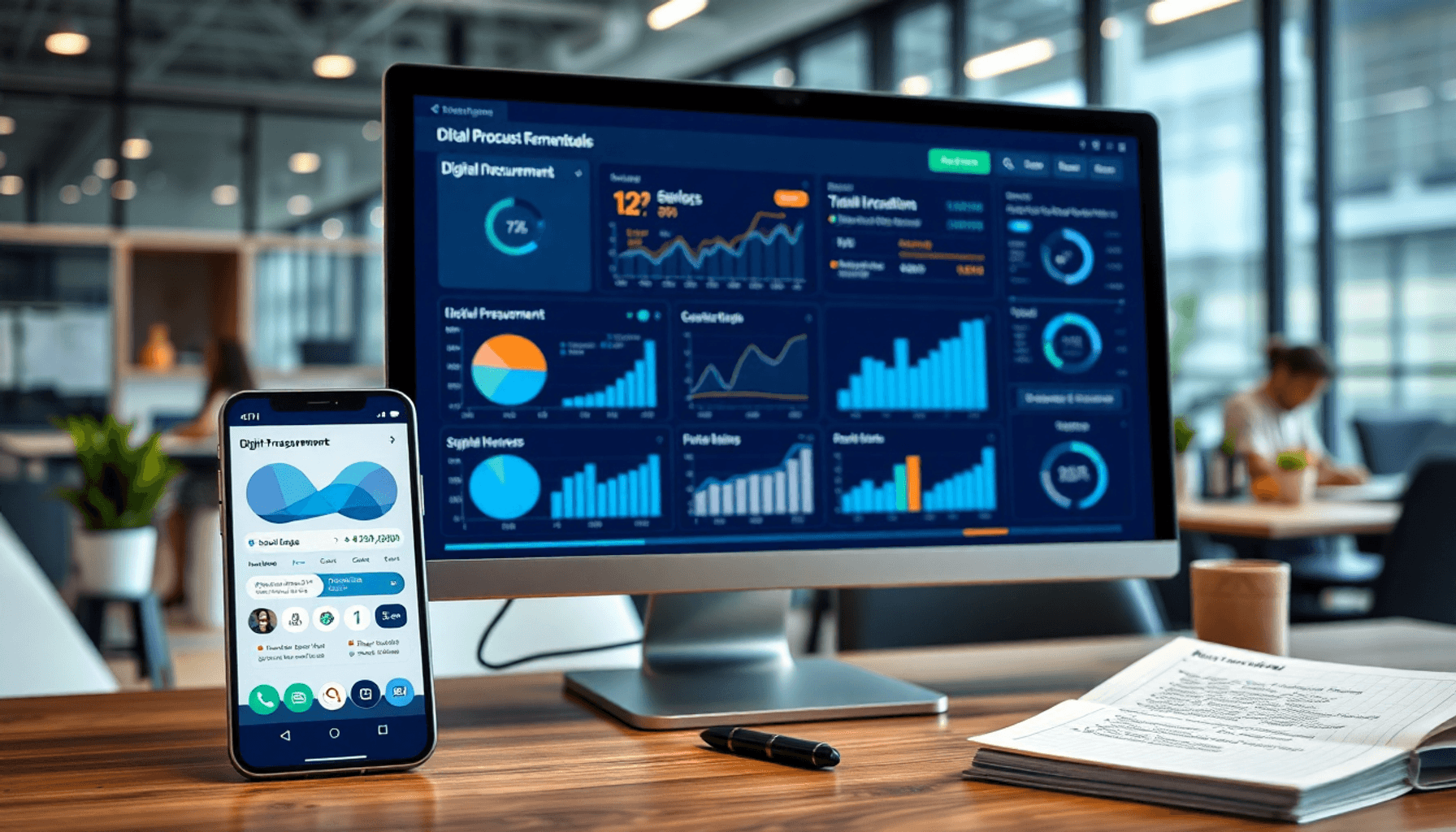Introduction
B2B procurement digitalization represents a significant shift in how businesses manage their purchasing processes. This transformation leverages technology to enhance efficiency and streamline interactions between buyers and suppliers. Key aspects include:
- Increased Efficiency: Automation reduces manual tasks, speeding up workflows.
- Enhanced Customer Experience: Digital tools provide buyers with greater control over their purchasing decisions.
Digital transformation in procurement is essential for businesses aiming to remain competitive and meet evolving customer expectations. Organizations that embrace these changes can achieve substantial operational improvements and cost savings.
A notable example of successful implementation is Hubzone Depot LLC, a certified HUBZone small business. Their strategic use of digital strategies illustrates how companies can optimize their procurement processes, ultimately driving enhanced performance and customer satisfaction. This includes leveraging digital tools not only to streamline supply chain processes but also to boost employee morale with efficient procurement of break room supplies.
Furthermore, the company’s approach serves as a model for those looking to kickstart their career in supply chain or seeking ways to build resilience during tough times in the procurement process.
The Shift to Digital Engagement
The COVID-19 pandemic has significantly accelerated the shift towards digital engagement in B2B procurement processes. Traditional procurement methods faced disruptions, prompting businesses to adapt quickly to new realities. This transformation is characterized by:
- Increased reliance on technology: Companies have adopted various digital tools to streamline operations and maintain supplier relationships.
- Emergence of self-service options: B2B buyers now expect the ability to manage their purchasing independently, allowing them to make decisions quickly and efficiently.
- Facilitation of remote interactions: Video conferencing and online communication platforms have become essential for maintaining connections with suppliers, replacing face-to-face meetings that were once standard.
The benefits of these changes are evident:
- Efficiency: Self-service options enable faster decision-making and reduce administrative burdens.
- Accessibility: Remote interactions provide flexibility, allowing procurement teams to connect with suppliers from anywhere.
- Enhanced user experience: Digital engagement fosters a more streamlined purchasing process, meeting customer expectations for speed and convenience.
As organizations embrace these changes, the focus on digital engagement will only intensify, shaping future procurement strategies. This evolution also opens up opportunities for group purchasing organizations (GPOs), which offer significant benefits in the private sector.
Moreover, it is essential to consider the role of diversity, equity, and inclusion (DEI) in this digital transformation. Embracing DEI can lead to more innovative supplier relationships and better understanding of diverse market needs.
Finally, as we navigate through this digital shift, it’s crucial to stay informed about the top trends in supplier innovation that could further enhance our procurement strategies.
Increased Online Purchasing in B2B
The trend of online purchasing has gained substantial traction among B2B buyers, particularly decision-makers. A cultural shift has emerged where these professionals feel increasingly comfortable making significant investments through digital platforms. This evolution in buyer behavior is largely attributed to the accessibility and efficiency that self-service channels offer.
Consider the following statistics:
- 70% of decision-makers now prefer online channels for their procurement needs.
- 60% report that they have made large purchases—often exceeding $100,000—through self-service options in the past year.
The ability to conduct transactions remotely not only streamlines the procurement process but also empowers decision-makers to take control of their purchasing decisions. They seek transparency, speed, and convenience in their interactions with suppliers. As a result, vendors who provide robust online purchasing capabilities are at an advantage, catering to a clientele that values flexibility and efficiency.
Interestingly, this shift towards online purchasing has also sparked discussions around myths related to Group Purchasing Organizations (GPOs), which are often confused with traditional group purchasing practices. It’s essential for organizations to understand the differences between purchasing groups and Group Purchasing Organizations to leverage these new procurement channels effectively.
In this evolving landscape, organizations must adapt to meet the preferences of these empowered buyers. Embracing digital solutions will prove crucial for maintaining competitiveness in the B2B space.
Emergence of New Channels for Procurement
The world of B2B procurement is changing quickly. Video conferencing and live chat are becoming important tools for sales conversations. The COVID-19 pandemic has greatly sped up this shift to digital, forcing businesses to use technologies that make remote communication easier.
Advantages of New Channels
These new channels offer several advantages over traditional methods:
- Flexibility: Video conferencing allows for real-time discussions, enabling decision-makers to engage with suppliers without geographical constraints.
- Efficiency: Live chat provides instant responses to queries, streamlining the decision-making process.
- Enhanced Interaction: These tools foster a more personal connection than traditional emails or phone calls, enhancing trust and collaboration.
Comparison with Traditional Meetings
While face-to-face meetings have long been the gold standard in B2B interactions, they come with limitations:
- Time-Consuming: Scheduling and travel can delay discussions.
- Costly: In-person meetings often incur additional expenses such as travel and accommodation.
In contrast, video conferencing and live chat reduce these barriers, offering a cost-effective and timely alternative. Embracing these digital channels not only improves engagement but also aligns with the growing trend towards self-service options in procurement. The shift towards these technologies underscores the importance of adapting to new methods that meet evolving buyer expectations.
Moreover, as businesses navigate through these changes, it’s crucial to consider the safety measures required during any in-person interactions. This is particularly relevant in sectors such as healthcare where essential PPE for airborne precautions is necessary to ensure safety.
Long-Term Digital Adoption Trends in B2B Procurement
The world of B2B procurement is going through a major change. Many organizations are seeing digital adoption as a permanent shift rather than a temporary solution. Experts predict that this trend will keep growing, with businesses focusing on long-term strategies to improve their digital skills.
Key components of sustained digital adoption include:
- Integration of Advanced Technologies: Tools like artificial intelligence (AI) and machine learning (ML) are essential for automating procurement tasks, increasing precision, and enabling decisions based on data.
- Focus on Sustainability: Organizations are placing greater importance on sustainable practices in their procurement plans. This change not only aligns with corporate social responsibility but also satisfies the rising demand for eco-friendly products.
- Enhanced Supplier Collaboration: Digital platforms make it easier to communicate and work together with suppliers. Greater visibility into supply chains fosters openness and strengthens partnerships.
These approaches will empower organizations to swiftly adjust to market shifts, make the most of their resources, and improve efficiency. As businesses continue to fine-tune their digital procurement methods, the focus remains on being flexible and resilient in a constantly changing marketplace.
Gaining Competitive Advantage through Digital Procurement Practices
Effective digital procurement practices can significantly enhance your business’s operational efficiency and provide a competitive edge in the marketplace.
Key benefits include:
-
Cost Reduction Strategies: Implementing digital tools allows for better spend analysis, enabling businesses to identify areas for cost savings. Automated procurement processes reduce administrative overhead, freeing up resources for strategic initiatives.
-
Streamlined Supplier Interactions: Digital platforms facilitate quicker communication and collaboration with suppliers. This leads to more transparent negotiations, improved supplier relationships, and ultimately better pricing.
-
Enhanced Data Utilization: Access to real-time data analytics empowers decision-makers to make informed choices. Organizations can track purchases, monitor supplier performance, and adjust strategies based on actionable insights.
-
Meeting Customer Expectations: Adopting modern interaction methods through technology ensures that businesses can respond swiftly to customer needs. Providing self-service options and personalized experiences enhances customer satisfaction and loyalty.
Integrating these digital procurement practices not only drives operational improvements but also positions your organization as a forward-thinking leader in procurement. By leveraging technology effectively, you can create lasting value while meeting the evolving demands of both customers and suppliers.
Hubzone Depot LLC: A Case Study in B2B Procurement Digitalization
Strategies Employed by Hubzone Depot in Their Procurement Processes
Hubzone Depot LLC exemplifies successful B2B procurement digitalization through innovative strategies that optimize their procurement processes. This certified HUBZone small business and women-owned enterprise prioritizes technology to enhance supplier selection and negotiation outcomes. Below are key strategies employed by Hubzone Depot:
1. Strategic Sourcing Techniques
Utilizing data analytics, Hubzone Depot identifies the best suppliers based on performance metrics and historical data. This approach ensures that decision-makers have access to reliable information, improving the accuracy of choices made during procurement.
2. Technology Integration
By adopting advanced procurement software, the company streamlines interactions with suppliers. This integration facilitates real-time communication and document sharing, enhancing efficiency throughout the purchasing lifecycle.
3. Supplier Relationship Management
Hubzone Depot emphasizes building strong relationships with suppliers. Regular feedback loops help maintain high service standards while fostering collaboration for better pricing and terms.
4. HUBZone Compliance
Maintaining HUBZone compliance not only differentiates Hubzone Depot in a competitive market but also strengthens trust with public sector clients. The certification showcases their commitment to supporting economic growth in historically underutilized business zones.
5. Women-Owned Business Advantage
As a woman-owned business, Hubzone Depot taps into specific initiatives and funding opportunities aimed at promoting diversity in procurement practices. This strategic positioning opens doors for partnerships and contracts that may not be available to other firms.
Through these strategies, including procurement optimization, Hubzone Depot LLC effectively navigates the complexities of digital procurement, proving that embracing technology can lead to enhanced supplier interactions and improved operational outcomes. The company’s focus on strategic sourcing techniques positions them as a leader in B2B procurement digitalization, driving value for their clients while ensuring compliance with industry standards.
Impact of Certifications on Hubzone Depot’s Operations and Supplier Interactions
Hubzone Depot LLC, as a certified HUBZone small business and women-owned enterprise, uses its certifications to improve its operations and relationships with suppliers. The benefits of certifications go beyond just following rules; they offer significant advantages in the competitive world of B2B procurement:
1. Differentiation
HUBZone compliance allows Hubzone Depot to stand out among suppliers, attracting public sector clients committed to supporting underrepresented communities.
2. Government Contracting Opportunities
Certifications open doors to exclusive government contracts that prioritize businesses like Hubzone Depot, facilitating growth and collaboration.
3. Enhanced Credibility
Certification signals reliability and trustworthiness to potential suppliers and clients, fostering stronger partnerships.
4. Access to Resources
Being a certified women-owned business grants access to specialized programs and resources aimed at empowering diverse suppliers.
These factors create a strong foundation for strategic sourcing techniques that improve supplier interactions and operational efficiency. For example, using effective tail spend management strategies can greatly optimize cost efficiency. Additionally, focusing on supplier relationship management can foster stronger partnerships with suppliers, further enhancing operational effectiveness.
Best-in-Class Service Integrity at Hubzone Depot LLC
Hubzone Depot LLC, a certified HUBZone small business and women-owned enterprise, prioritizes service integrity in its B2B procurement digitalization efforts. This commitment is reflected in their four-stage method designed to ensure quality throughout the procurement process:
- Initial Supplier Evaluation: Rigorous assessment of potential suppliers based on their capabilities and compliance standards.
- Contract Negotiation: Strategic sourcing techniques are employed to secure favorable terms while ensuring alignment with HUBZone compliance.
- Performance Monitoring: Continuous oversight during the delivery phase to maintain high service standards and adherence to contractual obligations, a process that significantly helps in maximizing supplier performance.
- Post-Delivery Review: Evaluation of supplier performance against established benchmarks, facilitating improvements and adjustments as necessary.
This structured approach not only enhances operational efficiency but also reinforces Hubzone Depot’s mission to support underrepresented communities through government contracting opportunities. By leveraging the best procurement software and outsourcing companies, they are revolutionizing their procurement strategy, ultimately leading to sustained success in the competitive procurement landscape.
Cost Savings & Flexible Ordering Options Offered by Hubzone Depot LLC
Hubzone Depot LLC, a certified HUBZone small business and women-owned enterprise, is dedicated to supporting underrepresented communities through government contracting opportunities. Their mission emphasizes providing accessible solutions for public sector clients.
Key cost reduction strategies include:
- No Purchase Minimums: Clients can order as needed without the pressure of meeting minimum purchase requirements.
- Indexed Pricing Models: These flexible pricing structures adapt to market conditions, ensuring that clients receive competitive rates while maintaining budgetary control.
A notable case involved a government agency that leveraged Hubzone Depot’s offerings. By utilizing their strategic sourcing techniques, the agency achieved significant savings while ensuring high-quality products and timely delivery. This approach exemplifies how effective procurement digitalization can enhance operational efficiency and financial performance for organizations navigating complex purchasing landscapes. Such strategies are part of the power of leveraging drastic cost reduction through collective spend, which emphasizes the importance of collective purchasing in achieving substantial savings.
Moreover, Hubzone Depot’s mission aligns with the principles outlined in the art of frugal living, which focuses on maximizing cost savings in daily life. This philosophy is reflected in their commitment to providing flexible ordering options and cost-saving strategies for their clients.
Conclusion: Embracing Digital Transformation for Future-Ready B2B Procurement Strategies
Digital transformation is no longer optional for businesses aiming to thrive in the competitive landscape of B2B procurement.
Key reasons to embrace this shift include:
- Enhanced Efficiency: Streamlined processes lead to time and cost savings.
- Improved Supplier Relationships: Technology facilitates better communication and collaboration.
- Increased Flexibility: Adaptability to market changes becomes a core strength.
Companies like Hubzone Depot LLC exemplify how leveraging technology-enabled solutions can pave the way towards future-ready B2B procurement strategies. Their innovative approaches, such as indexed pricing models and no purchase minimums, highlight the potential for significant operational improvements. Moreover, they provide valuable insights into optimizing a one-person procurement function, which can be a game-changer for small businesses or startups.
Investing in digital tools not only meets evolving customer expectations but also positions organizations as leaders in their sectors. This aligns with the experiences shared by Frank Corris, who emphasizes the importance of continuous learning and strategic thinking in driving procurement success.
By prioritizing digital procurement practices, businesses can unlock new growth opportunities, optimize resource allocation, and respond effectively to market dynamics. The future outlook for B2B procurement digitalization is bright, emphasizing the need for companies to act decisively and embrace these advancements for sustained success. As we look ahead, understanding salary trends for procurement engineers could also provide valuable insights for those considering a career in this field.






